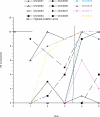'MetaTaal': enhancing complex syntax in children with specific language impairment--a metalinguistic and multimodal approach
- PMID: 25703047
- PMCID: PMC4492443
- DOI: 10.1111/1460-6984.12131
'MetaTaal': enhancing complex syntax in children with specific language impairment--a metalinguistic and multimodal approach
Abstract
Background: Currently, most research on the effective treatment of morphosyntax in children with specific language impairment (SLI) pertains to younger children. In the last two decades, several studies have provided evidence that intervention for older school-age children with SLI can be effective. These metalinguistic intervention approaches teach grammatical rules explicitly and use shapes and colours as two-dimensional visual support. Reading or writing activities form a substantial part of these interventions. However, some children with SLI are poor readers and might benefit more from an approach that is less dependent on literacy skills.
Aims: To examine the effectiveness of a combined metalinguistic and multimodal approach in older school-age children with SLI. The intervention was adapted to suit poor readers and targeted the improvement of relative clause production, because relative clauses still pose difficulties for older children with SLI.
Methods & procedures: Participants were 12 monolingual Dutch children with SLI (mean age 11;2). All children visited a special school for children with speech and language disorders in the Netherlands. A quasi-experimental multiple-baseline design was chosen to evaluate the effectiveness of the intervention. A set of tasks was constructed to test relative clause production and comprehension. Two balanced versions were alternated in order to suppress a possible learning effect from multiple presentations of the tasks. After 3 monthly baseline measurements, the children received individual treatment with a protocolled intervention programme twice a week during 5 weeks. The tests were repeated directly post-therapy and at a retention measurement 3 months later. During the intervention programme, the speech therapist delivering the treatment remained blind to the test results.
Outcomes & results: No significant changes were found during the baseline measurements. However, measurement directly post-therapy showed that 5 h of intervention produced significant improvement on the relative clause production tasks, but not on the relative clause comprehension task. The gains were also maintained 3 months later.
Conclusions & implications: The motor and tactile/kinesthetic dimensions of the 'MetaTaal' metalinguistic intervention approach are a valuable addition to the existing metalinguistic approaches. This study supports the evidence that grammatical skills in older school-age children with SLI can be remediated with direct intervention using a metalinguistic approach. The current tendency to diminish direct intervention for older children with SLI should be reconsidered.
Keywords: Dutch; intervention; metalinguistic; multimodal; school-age children with SLI; specific language impairment.
© 2015 Royal College of Speech and Language Therapists.
Figures












Similar articles
-
Predicting word decoding and word spelling development in children with Specific Language Impairment.J Commun Disord. 2011 May-Jun;44(3):392-411. doi: 10.1016/j.jcomdis.2010.12.002. Epub 2010 Dec 25. J Commun Disord. 2011. PMID: 21251668
-
Relative clause constructions in children with specific language impairment.Int J Lang Commun Disord. 2014 Mar-Apr;49(2):255-64. doi: 10.1111/1460-6984.12070. Epub 2013 Dec 4. Int J Lang Commun Disord. 2014. PMID: 24304939
-
Theory of mind and emotion recognition skills in children with specific language impairment, autism spectrum disorder and typical development: group differences and connection to knowledge of grammatical morphology, word-finding abilities and verbal working memory.Int J Lang Commun Disord. 2014 Jul-Aug;49(4):498-507. doi: 10.1111/1460-6984.12091. Epub 2014 May 29. Int J Lang Commun Disord. 2014. PMID: 24888967
-
Interventions for children's language and literacy difficulties.Int J Lang Commun Disord. 2012 Jan-Feb;47(1):27-34. doi: 10.1111/j.1460-6984.2011.00081.x. Epub 2011 Oct 5. Int J Lang Commun Disord. 2012. PMID: 22268899 Free PMC article. Review.
-
Interventions for children with dyslexia: A review on current intervention methods.Med J Malaysia. 2018 Oct;73(5):311-320. Med J Malaysia. 2018. PMID: 30350811 Review.
Cited by
-
An Implicit-Explicit Framework for Intervention Methods in Developmental Language Disorder.Am J Speech Lang Pathol. 2022 Jul 12;31(4):1557-1573. doi: 10.1044/2022_AJSLP-21-00172. Epub 2022 Apr 21. Am J Speech Lang Pathol. 2022. PMID: 35446629 Free PMC article.
-
Sentences Are Key: Helping School-Age Children and Adolescents Build Sentence Skills Needed for Real Language.Am J Speech Lang Pathol. 2024 Mar 7;33(2):564-579. doi: 10.1044/2023_AJSLP-23-00038. Epub 2023 Aug 29. Am J Speech Lang Pathol. 2024. PMID: 37643470 Free PMC article.
-
Explicit Grammatical Intervention for Developmental Language Disorder: Three Approaches.Lang Speech Hear Serv Sch. 2020 Apr 7;51(2):226-246. doi: 10.1044/2019_LSHSS-19-00046. Epub 2020 Apr 7. Lang Speech Hear Serv Sch. 2020. PMID: 32255746 Free PMC article.
-
Enhancing Syntactic Knowledge in School-Age Children With Developmental Language Disorder: The Promise of Syntactic Priming.Am J Speech Lang Pathol. 2024 Mar 7;33(2):580-597. doi: 10.1044/2023_AJSLP-23-00079. Epub 2023 Sep 7. Am J Speech Lang Pathol. 2024. PMID: 37678208 Free PMC article. Review.
-
A New Memory Perspective on the Sentence Comprehension Deficits of School-Age Children With Developmental Language Disorder: Implications for Theory, Assessment, and Intervention.Lang Speech Hear Serv Sch. 2021 Apr 20;52(2):449-466. doi: 10.1044/2021_LSHSS-20-00128. Epub 2021 Apr 7. Lang Speech Hear Serv Sch. 2021. PMID: 33826402 Free PMC article. Review.
References
-
- ADAMS C. Syntactic comprehension in children with expressive language impairment. British Journal of Disorders of Communication. 1990;25:149–171. - PubMed
-
- ARAM DM, EKELMAN BL, NATION JE. Pre-schoolers with language disorders: 10 years later. Journal of Speech and Hearing Research. 1984;27:232–244. - PubMed
-
- BRYAN A. Colourful semantics. In: Chiat S, Law J, Marshall J, editors. Language disorders in children and adults: Psycholinguistic approaches to therapy. Whurr; London: 1997. pp. 143–161.
-
- BEITCHMAN JH, WILSON B, BROWNLIE EB, WALTERS H, LANCEE W. Long-term consistency in speech/language profiles: 1. Developmental and academic outcomes. Journal of the American Academy of Child and Adolescent Psychiatry. 1996;35:804–814. - PubMed
-
- BIRSH JR. Multisensory Teaching of Basic Language Skills. 2nd Edition Paul H. Brookes Publishing Co.; Baltimore MD: 2005.
MeSH terms
Grants and funding
LinkOut - more resources
Full Text Sources
Other Literature Sources

